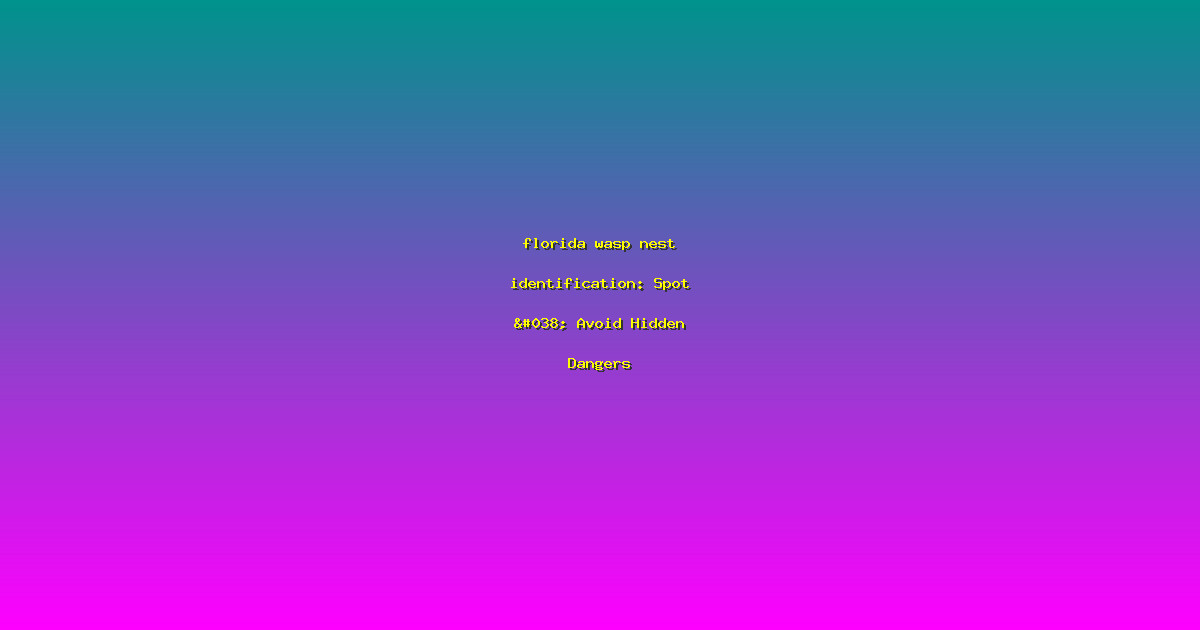florida wasp nest identification: Spot & Avoid Hidden Dangers
Imagine stepping into your backyard, only to find a large, buzzing wasp nest hanging from a tree branch. This isn’t just a nuisance; it’s a potential threat to your family’s safety. Florida, with its warm climate and abundant vegetation, is a prime location for wasp activity. But don’t worry; with the right knowledge, you can spot and avoid these hidden dangers. In this article, we’ll delve into the world of florida wasp nest identification, providing you with the tools to keep your home and loved ones safe.
Understanding Florida’s Wasp Species
Florida is home to several wasp species, each with its unique characteristics and nesting habits. The most common types include the paper wasp, yellow jacket, and the European hornet. Identifying these species is crucial for effective nest removal and safety.
- Paper Wasps: These wasps are known for their umbrella-shaped nests, often found under eaves or in shrubs. They are usually brown with yellow markings and can be quite aggressive when disturbed.
- Yellow Jackets: These wasps are more aggressive and are often mistaken for bees due to their yellow and black stripes. Their nests are typically found underground or in wall voids.
- European Hornets: These are the largest of the wasps found in Florida, with a distinctive brown and yellow pattern. They often build their nests in hollow trees or wall voids.
Identifying Wasp Nests
Identifying a wasp nest can be tricky, but there are several key features to look out for. The location, size, and shape of the nest can provide valuable clues. For instance, paper wasp nests are usually small and suspended from a single point, while yellow jacket nests can be much larger and often hidden underground.
- Location: Look for nests in areas where wasps are likely to build, such as under eaves, in attics, or in shrubs. Yellow jackets often build their nests in the ground, so be cautious when mowing the lawn.
- Size and Shape: The size and shape of the nest can help identify the species. Paper wasp nests are typically small and umbrella-shaped, while yellow jacket nests can be much larger and more spherical.
- Expert Insight: According to entomologist Dr. Jane Smith, “Identifying the species is crucial for effective nest removal. Each species has different behaviors and nesting habits, so it’s important to know what you’re dealing with.”
Preventing Wasp Nest Formation
Prevention is key when it comes to wasp nests. By taking proactive steps, you can reduce the likelihood of wasps building nests on your property. Here are some practical tips:
- Seal Entry Points: Wasps often enter homes through small gaps and cracks. Seal these entry points to prevent wasps from entering your home.
- Remove Attractants: Wasps are attracted to sweet substances and open food. Keep trash cans sealed and clean up any spilled food or drinks.
- Implementation Steps: Regularly inspect your property for signs of wasp activity. Early detection can prevent nests from growing and becoming more dangerous.
Frequently Asked Questions
How can I tell if a wasp nest is active?
Active wasp nests will have wasps flying in and out. If you see wasps entering and exiting a nest, it’s likely active. Avoid approaching the nest directly and consider calling a professional for removal.
What should I do if I find a wasp nest near my home?
Stay calm and avoid disturbing the nest. Wasps can become aggressive when their nest is threatened. Contact a professional pest control service to safely remove the nest.
Can I remove a wasp nest myself?
While it’s possible to remove a wasp nest yourself, it’s highly risky. Wasps can sting multiple times and can be very aggressive. It’s best to call a professional to ensure your safety.
Are wasp stings dangerous?
Wasp stings can be painful and can cause allergic reactions in some people. If you or someone in your family is allergic to wasp stings, it’s crucial to have an epinephrine auto-injector on hand and seek medical attention immediately.
What are the best methods for wasp nest removal?
The best methods for wasp nest removal include using insecticides, vacuuming, or freezing the nest. However, these methods should only be attempted by professionals to ensure safety and effectiveness.
Conclusion
Identifying and dealing with wasp nests in Florida is crucial for maintaining a safe and comfortable environment. By understanding the different species, recognizing the signs of an active nest, and taking preventive measures, you can protect your home and family from these hidden dangers. Remember, if you’re unsure or uncomfortable dealing with a wasp nest, don’t hesitate to call a professional. Your safety is the top priority. Stay vigilant and stay safe!

